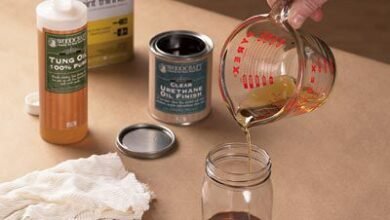Spar urethane is a popular wood finish that provides excellent protection for both indoor and outdoor projects. Here’s a comprehensive guide on spar urethane, including application techniques, differences from regular polyurethane, and answers to related questions.
How to Apply Spar Urethane
- Surface Preparation:
- Ensure the wood surface is clean, dry, and free of dust
- Sand the surface with 120-150 grit sandpaper
- Remove sanding dust with a vacuum or mineral spirits-dampened cloth
- Application Methods:
a) Brush Application:- Use a high-quality natural bristle brush and apply thin coats in one direction. Work quickly to maintain a wet edgeUse a dry brush to smooth from dry to wet areas perpendicularly
- Thin the spar urethane 50% with mineral spirits. Use a clean cotton rag as an applicator. Apply thin, smooth coats, overlapping each stroke
- Hold the can 10-12 inches from the surface
- Apply light mist coats in a steady back-and-forth motion
- Slightly overlap each stroke
- Drying and Recoating:
- Allow 4 hours of drying time between coats
- Sand lightly with fine-grit sandpaper (220 or higher) between coats
- Apply a minimum of 3 coats, with 4-5 coats recommended for maximum protection
Differences Between Spar Urethane and Regular Polyurethane
- Flexibility: Spar urethane is more flexible, expanding and contracting with wood movement
- UV resistance: Spar urethane contains UV-resistant additives, making it suitable for outdoor use
- Oil content: Oil-based spar urethane has a higher oil content, contributing to its flexibility
- Intended use: Spar urethane is designed for exterior projects, while polyurethane is better for indoor use
- Water resistance: Spar urethane offers superior water resistance
- Durability: Polyurethane generally provides a harder finish, ideal for high-traffic areas
- Chemical resistance: Polyurethane tends to be more resistant to chemicals and alcohol
Related Questions
- How many coats of spar urethane should I apply?
Apply at least 3 coats, with 4-5 coats recommended for maximum protection. - Can I use spar urethane on outdoor furniture?
Yes, spar urethane is ideal for outdoor furniture, doors, windows, fences, railings, and boats (above the water line). - Is sanding between coats necessary?
While some products claim it’s unnecessary, light sanding between coats is generally recommended for better adhesion. - How long should I wait before using the finished surface?
Allow 24 hours after the final coat before light use, and wait 3 days before subjecting the surface to normal usage. - Can I apply spar urethane over stained wood?
Yes, you can apply spar urethane over stained wood. Ensure the stain is completely dry before application. - Is spar urethane suitable for all outdoor projects?
While excellent for many outdoor applications, spar urethane is not recommended for decks, high-traffic areas, siding, or rough-sawn surfaces.
Following these guidelines, you can achieve a beautiful and durable finish on your wood projects using spar urethane.


